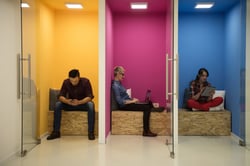Executive Summary:
- A healthy workplace contributes to the overall well-being of an employee, thus boosting productivity.
- A visitor management system is crucial in tracking employees and guests to reduce the infection spread.
- Touchless technology lessens the need for physical interaction and sharing of tools, with the separation minimizing the spread of COVID-19 and other infectious diseases.
With the emergence of omicon, the latest COVID-19 'variant of concern', and the number of deaths ticking towards 800,000, it’s understandable why the government placed stringent measures to halt its march. Lockdowns were the first to leave their mark on businesses, but supply chain issues soon came into play.
The economy suffered for it as it soon became apparent that stimulus packages could only go so far–businesses had to keep running. Thus began the push for creating healthy buildings and implementation of long-proposed measures to keep the workplace safe for workers and visitors.
Your priority as a business team leader is ensuring your workplace follows health protocols. Creating a healthier workplace can boost employee morale, lower turnover, and reduce disease infection rates and healthcare costs. Here’s how you can achieve that.
Reasons to Keep Your Workplace Healthy
- Contributes to overall health: according to the International WELL Buildings Institute (IWBI), there’s a correlation between humans and their built environment. A well-built workplace should improve their mood, nutrition, fitness, and sleep patterns, which might increase productivity. If possible, ensure your office building meets the WELL buildings criteria.
- Reduce the spread of infection: having a healthy workplace involves maintaining a clean and safe environment that reduces the amount of disease-causing pathogens. This minimizes the number of sick employees, brings down absenteeism rates, and improves productivity.

Tips on How to Keep Your Workplace Healthy
Reduce the Number of People
Encourage Vaccines and Booster Shots
Take Temperatures of all Employees and Visitors
Reduce Physical Touchpoints
Use Masks
Encourage Hand Washing
Institute Stringent Cleaning Protocols
Use Contact Tracing for Those Who Get Sick
Reduce the Number of People
 A healthy work environment is one where there is enough space. If you have a small office with many employees and tightly packed cubicles, you may wish to consider a hybrid work environment or moving to larger premises.
A healthy work environment is one where there is enough space. If you have a small office with many employees and tightly packed cubicles, you may wish to consider a hybrid work environment or moving to larger premises.
Better yet, rent space at healthy buildings, which will help contribute to employees’ well-being and job satisfaction.
If not, you may want to adopt a hybrid system that allows employees to alternate between working from home and the office.
Encourage Vaccines and Booster Shots
 Vaccines lessen the disease’s severity and the infection rate. With a herd mentality, vaccinated employees have slim chances of infecting vulnerable colleagues or guests. Introduce protocols requiring employees to get vaccines for infectious diseases.
Vaccines lessen the disease’s severity and the infection rate. With a herd mentality, vaccinated employees have slim chances of infecting vulnerable colleagues or guests. Introduce protocols requiring employees to get vaccines for infectious diseases.
You can even set up a vaccine drive at the office and encourage employees to participate. Booster shots are necessary because vaccines are not 100% foolproof.
Take the Temperatures of all Employees and Visitors
 Temperature screening is one of the focal points for determining whether a person is sick or not. The Centers for Disease Control and Prevention states that a temperature of 100.4°F (38°C) is an early indicator of fever and infection.
Temperature screening is one of the focal points for determining whether a person is sick or not. The Centers for Disease Control and Prevention states that a temperature of 100.4°F (38°C) is an early indicator of fever and infection.
A visitor management system with integrated thermal temperature scanning inspects every person’s temperature whenever they step into the premises, ensuring employee health and safety, while improving productivity.
Reduce Physical Touchpoints
A digital receptionist handles all the administrative work from managing appointments, logging visitor data, and seamless sign-in. It eliminates the need for physical contact and interaction, which contributes to the spread of infectious diseases.
Use Masks
Wearing face masks helps reduce airborne disease spread. Not all diseases present symptoms immediately, so an employee may be infectious without knowing it.
Encourage your employees to wear face masks at work to help protect themselves and others from infectious diseases. Have extra masks at your facility to cater to employees who may lose or damage theirs.
Encourage Hand Washing
Ensure your employees, contractors, and customers have access to places they can wash their hands with soap and water.
Additionally, place hand sanitizer dispensers in strategic locations around the office. Alcohol-based sanitizers should contain at least 60% of alcohol to be effective against disease-causing germs.
Institute Stringent Cleaning Protocols
Frequent cleaning diminishes the presence and spread of germs on surfaces. Cleaning at least once a day with soap or detergent is enough to eliminate a virus, thus preventing infection spread.
With a visitor management system, you can easily keep track of anyone who visited your facility and tested positive for a contagious disease. You can then take cleaning and disinfecting measures in the affected area to reduce the risk of infection among employees.
Moreover, you can install tech that monitors, filters, and purifies the interior air in your workplace. These replace all the air inside the building every 10-15 minutes
Use Contact Tracing for Those Who Get Sick
Having the means to trace sick employees helps protect healthy employees from infection. Technology companies embrace a sign-in system that enables them to track employees and visitors, thus preventing the spread of illnesses.
Visitor management software includes ID scanning that tracks employee and visitor data. The system recognized government-issued ID cards allowing for a seamless and secure check-in process. If an employee falls sick, you can quickly identify and trace them.
Challenges You May Face
Keeping the workplace healthy is not always an easy task. These are some challenges you may encounter:
Maintaining Social Distancing
Delayed Symptoms
Maintaining Social Distancing
You will need to ensure employees maintain social distancing, which is challenging for smaller offices. If possible, adopt a hybrid workplace where some employees work from the office, and others work from home.
Delayed Symptoms
Some diseases may take several days before presenting any symptoms. If an employee or guest falls sick and doesn’t exhibit symptoms, this poses a risk if they come to the business premises.
That means even if you observe preventive measures, there is still a chance a worker or visitor may infect others.
Summary- A Visitor Management System Contributes to a Healthy Workplace
A sign-in system helps create a healthier working environment as employees return to work. This touchless visitor management system keeps track of employees and guests who frequent the workplace, making it easy to carry out contact tracing in a disease outbreak.
The system encourages contactless interaction, reducing the spread of germs and minimizing employee sickness, which improves employee productivity.